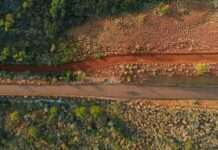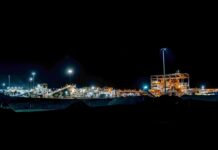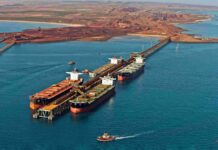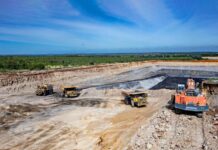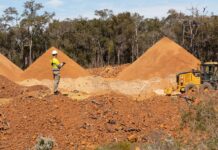DAMPIER Salt is one of the world’s largest exporters of seaborne salt and one of Rio Tinto’s oldest businesses, having grown pure salt for more than 50 years.
The company’s high-quality, natural and solar salt is valued by large industrial customers across Asia, with supply being sent to chlor-alkali plants in Japan, Korea, Taiwan, China and Southeast Asia.
The three operations are near its primary customers in Asia, reducing shipping costs and time.
Dampier Salt owns and manages the deep-water ports at Dampier and Lake MacLeod, and from Port Hedland where it has guaranteed berth access from the Pilbara Ports Authority.
The ports can accommodate a range of vessel sizes, with the shipping process safely managed by Rio Tinto Marine.
The hot, dry climate and low rainfall of the Pilbara and Gascoyne regions allow the company to harness the renewable power of the sun and wind for 99pc of its energy needs.
As the world’s largest exporter of solar salt, Dampier Salt is well-positioned to respond quickly to increased demand from each of its operations.
In 2019, Dampier Salt production was 8mt. The company has the capability to increase salt production by 3mtpa, should market demand increase.
Although there is latent capacity, Dampier Salt general manager operations Brendon Brodie-Hall said he does not see a need to expand production capacity in the next five years.
“Should future demand justify this, brownfield capacity expansions upwards of 3mt could be achieved in a short time frame and at a lower cost than greenfield projects currently being studied in WA,” he said.
The company also has no plans to expand its port operations as they are currently well-equipped to fulfill shipping requirements and demand.
The Dampier and Port Hedland operations are located right next to the pristine Indian Ocean, providing the seawater crucial to growing our pure, natural salt.
The shallow evaporation flats have the potential to produce salt virtually infinitely.
From the sky, the Dampier and Port Hedland operations look like a giant keyboard, made up of concentration ponds.
Up to 1mt of seawater is pumped into these ponds each day.
The pumps are very large and each one can pump 10,000m3 per hour, equivalent to filling four Olympic sized swimming pools an hour.
At the Lake MacLeod operation, seawater flows naturally underground through the porous limestone located at the north end of the naturally occurring lake, kick-starting the evaporation process.
The salt produced is used by the chemical industry to make products essential for modern life like glass, paper, plastics, textiles and even soaps and detergents.
Some of the salt is also used by downstream customers to process foods and de-ice roads.
Other markets for the final product – clean, white, coarse salt crystals – is used to produce caustic soda, which is in turn used for the refinement of bauxite in the alumina production process.
This is then sent to smelters for processing into aluminium.
Gypsum
High purity, natural gypsum is produced at the Lake MacLeod operation and supplied to the building products industry.
Purchased by Dampier Salt in 1978, the Lake MacLeod operation stated to produce gypsum concurrently with salt in 1997.
The operation has the lease of 219,200ha on Lake McLeod, from which brine and gypsum are obtained, and currently operates 400ha of crystallizing ponds.
Due to resurgent demand from Southeast Asia, there is real potential to expand production of gypsum to between 1.2 to 1.5mtpa.
Underpinned by a large-scale, homogenous, high-purity, surface-level resource, there is the potential for further low-cost expansion to fully utilise installed port infrastructure at Cape Cuvier.
Dampier Salt’s gypsum is suitable for use in both cement and plasterboard end use applications.
Strong construction growth is driving demand in Southeast Asia. Environmental restrictions on coal-based power plants are expected to reduce the production of synthetic gypsum in coming years, further increasing demand for natural gypsum in countries such as Japan and Korea.
Automation
Dampier Salt is committed to investing in innovative processes within its business.
Dampier Salt is working in partnership with Scania to explore automated light trucks for the harvesting of salt across its operations.
In late 2019, Dampier Salt completed a light truck automation trial, which had the potential to increase productivity and safety benefits for the business, as well as develop the skills of its staff.
“Smaller autonomous trucks have the potential to change the landscape of open-pit mining in the next decade and deliver economic and mine-design benefits,” Mr Brodie-Hall said.
“In 2020 we plan to continue these trials, leveraging the technical expertise in Rio Tinto for which we are renowned.”
At the Dampier operation, its automated washplant produces shipping-ready salt that is conveyed seven kilometres directly to the ship loader, setting the industry benchmark for operating costs.
Joint venture
Dampier Salt Limited is a joint venture between Rio Tinto (68pc), Marubeni Corporation (22pc) and Sojitz (10pc).
The first Dampier Salt operation was established at Dampier in 1967, with salt produced by the evaporation of seawater. The Dampier operation covers 10,000ha.
Dampier Salt acquired the 9000ha Port Hedland operation in 2001, where salt is also produced by seawater evaporation.
The Lake MacLeod operation is 75km from Carnarvon, 900km north of Perth.
Salt is produced from underground brines that are 10 times more concentrated than seawater.
Dampier Salt has the capacity to load 75,000t vessels, at a rate of 3500tph, at all of its three ports.

